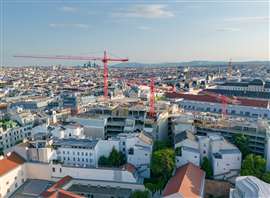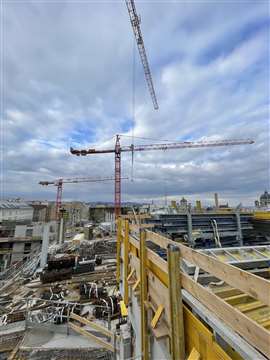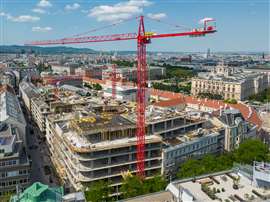Complex operations for three Wolff tower cranes
15 August 2023
 All three Wolff cranes up and running on the Lamarr development in downtown Vienna, Austria. Photo: Wolffkran
All three Wolff cranes up and running on the Lamarr development in downtown Vienna, Austria. Photo: Wolffkran
A trio of Wolff tower cranes are handling a complicated shopping centre job in the heart of Vienna, Austria. The Mariahilfer Straße, known locally as Mahü, is Vienna’s most popular shopping street. The under-construction Lamarr is being built on the site of the former Leiner furniture store. The development is named after the Austrian film diva Hedy Lamarr. The new department store will include an hotel and restaurants. A notable feature will be the green roof garden.
Austrian contractor Habau Hoch- und Tiefbau purchased a Wolff 8033.16 Cross for this project. In conjunction with another two Wolff towers the new crane is working on the building shell, due for completion by the end of 2023.
To cause minimal disruption to its busy surroundings Wolffkran planned it so only the 8033.16 with its 70 metre jib and 63.6 metre hook height needed a mobile crane to erect it. Once that was up it was used to erect the 7532.16 Cross (55 metre jib and 59.6 metre hook height). In turn, this second tower crane was used to erect the 6023.8 Clear flat top, with 42.5 metre jib and to a 46.5 metre hook height.
Erection of the second crane using the first saw it lifting close to its 16.2 tonne capacity limit. “For the assembly of the roughly 14 tonne jib of the Wolff 7532.16, our team had to calculate an overload hoist for the Wolff 8033.16 since the crane was statically reaching its limits at this point,” said Zeljko Tenjovic, Wolffkran Austria managing director.
 Space is so restricted on the development that materials and equipment are stored on every available surface, including the building itself. Photo: Wolffkran
Space is so restricted on the development that materials and equipment are stored on every available surface, including the building itself. Photo: Wolffkran
No space in or around
In addition to confined space in the public areas at ground level around the site, proximity of other buildings was also an issue.
Kurt Mörth, Habau site manager for large-scale construction projects, commented, “There is a high density of buildings all around. Neighbouring buildings may not be slewed over at all, and the areas frequented by pedestrians may not be slewed over with load.
“Furthermore, pipelines installed in the surrounding area and the existing underground parking garage limited the possible locations for the crane.”
Top of the list of challenges is yet to come, in the autumn, when the last of the three cranes will be dismantled. The two smaller second and third cranes (7532.16 and 6023.8) are standing in the middle of the new building they are working on, out of the reach of a mobile crane. The 16.5 tonne capacity 7532.16 will first dismantle the 8.5 tonne 6023.8.
Then the big 8033.16, standing 60 metres away, will go to work on the 7532.16. Its 13 tonne counter jib will need to be separated into two parts. “To handle this we need to release the bracings of the counter jib at the tower top and support the remaining jib section with special supports towards the crane tower before this component can then also be taken down,” said Zeljko Tenjovic.
“Apart from the reliability of the crane, one reason why we have been collaborating with Wolffkran for many years is the Wolffkran team’s long-standing experience. They find a competent and pragmatic solution for any challenge – big and small,” said Kurt Mörth. “When a hoist was damaged during a rope replacement, the Wolffkran team procured the most readily available spare part – from England.”
Habau and Wolffkran are also working together on the Harbor Portal project in Linz and the Vienna Twenty Two residential quarter in Vienna. Lamarr should be finished in 2024.
 Largest of the three towers on site is the Wolff 8033.16 with 70 metre jib. Photo: Wolffkran
Largest of the three towers on site is the Wolff 8033.16 with 70 metre jib. Photo: Wolffkran
STAY CONNECTED


Receive the information you need when you need it through our world-leading magazines, newsletters and daily briefings.




